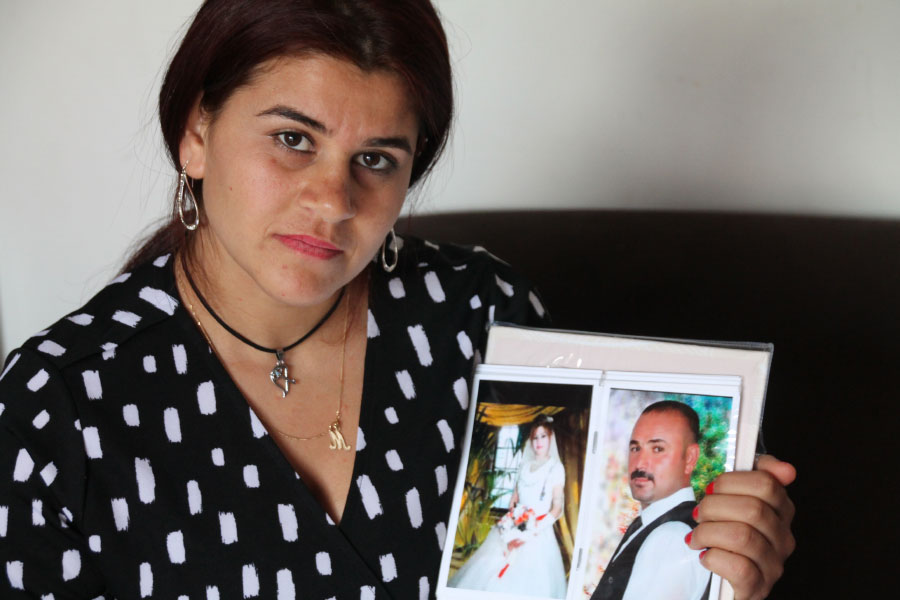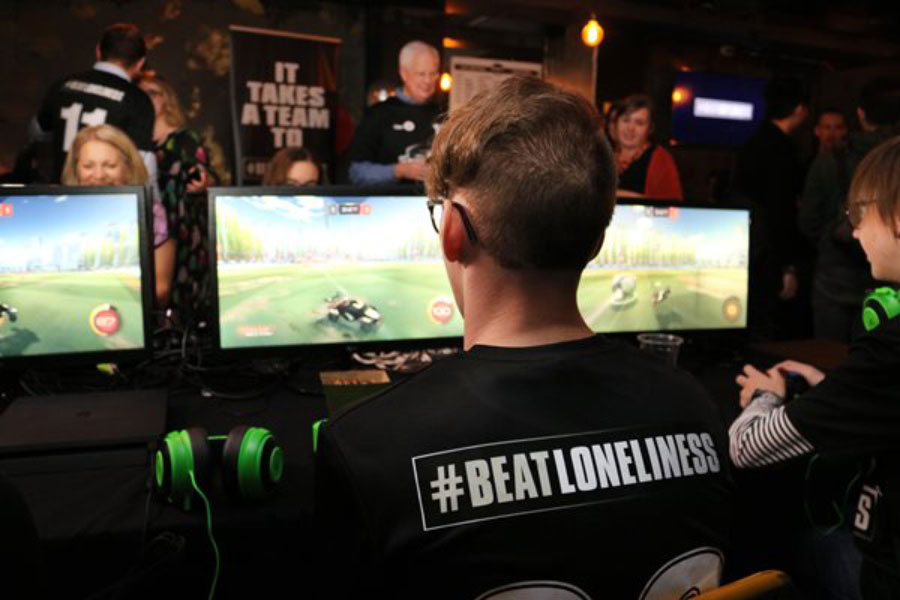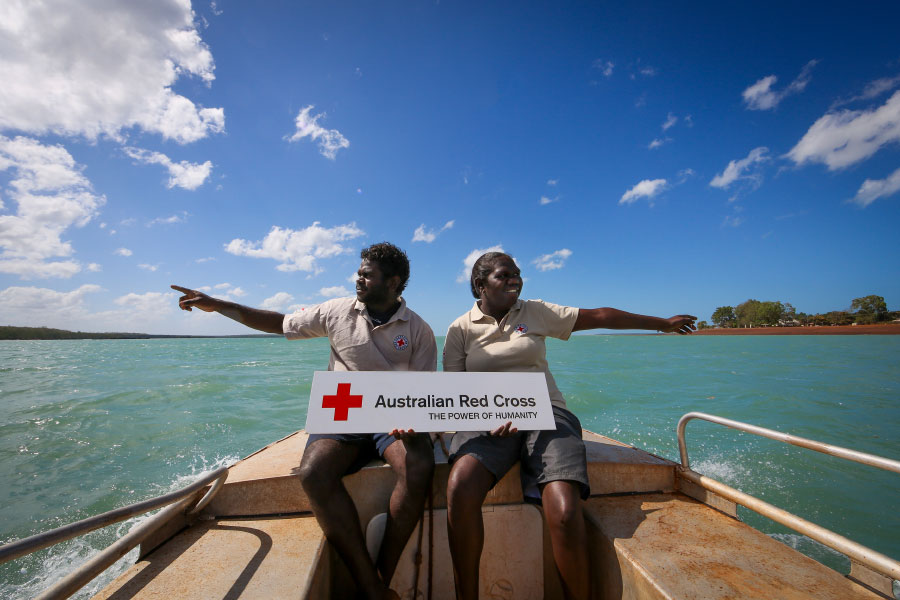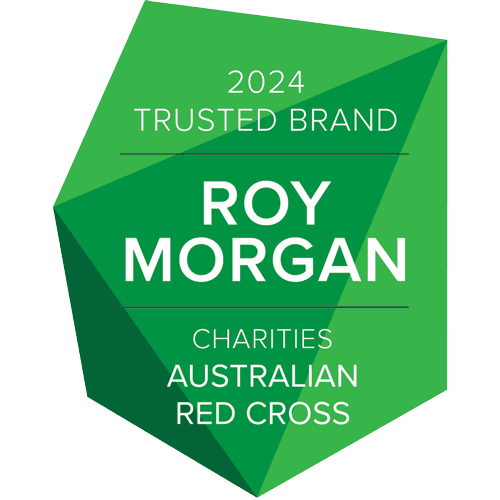Humanity: our bravest and most enduring tech trend
We all have a duty of care to the people we represent and communities we are a part of to ensure the human experience is central to new technologies, products and services. Keynote presentation delivered by Red Cross CEO Judy Slatyer at _southstart, a conference looking at the impact of emerging technologies on humans, on 21 November 2019.
Good morning.
Let me begin by acknowledging the Kaurna people, Traditional Owners of the land on which we meet today. I pay my respect to their Elders, past, present and emerging. I also acknowledge Aboriginal and Torres Strait Islander peoples in the audience, and the nations they come from.
I hear that yesterday you talked about teaspoons. You put those teaspoons on your hearts and that you did this, inspired by Ronni Khan, and in recognition that we all have a role to pay no matter how small. I also hear that you stepped into the technology discussion with eyes wide open – imagining what the future could look like with a real awareness of the positive and negative. And that you explored how to build a business with purpose – with the community or people genuinely at the centre.
Today I am keen to talk about bringing humanity and technology together with people at the core of what we can all imagine a good future. Humanity – our bravest and most enduring tech trend.
The Power of Humanity
Nurse Anne Carey helping to contain the Ebola epidemic in Sierra Leone. Courage, empathy, highly skilled bringing the most human of characteristics to bear in the most difficult of circumstances. We know technology will play a critical role in epidemics and pandemics in the future but we also know that community based awareness and prevention are just as powerful.

Wim driving people with chronic illnesses to hospital for chemotherapy and other treatments. I think we all remember Driving Miss Daisy. While the appointments are critical, it is more often the connection, conversation and time together which is the biggest help in soothing the emotions and building the strength in times like this
Rhiannon and 94-year-old Joan forming friendships over a cuppa and a laugh.
Brothers donating their $10 pocket money through crowd-funding so mums on Galiwinku Island can buy sewing machines and material to make clothes for their newborns.
The amazing courage we are seeing now from the emergency services workers and our volunteers and staff in responding the fires.
Every day, in so many ways, from welcoming new Australians to honouring first Australians, we see people walking alongside others, supporting people around them in the most difficult of circumstances.
We see the power of Humanity.
Technology is crucial to our work.
Technology helps us reach more people in need, faster, cost efficiently, and on a scale like never before.
Earlier this year, we mobilised more than 400 staff and volunteers to support over 52 thousand residents in the Townsville floods.
We ran evacuation centres, providing safety, comfort and kindness.
We ran Register.Find.Reunite, an online system which helps find and reunite family, friends and loved ones during a disaster.
We conducted more than 20 thousand phone calls providing psychological first aid in the days, weeks and months following.

It was one of the largest and longest Emergency Service activations in Australian Red Cross history.
Technology helps us trace and find missing loved ones, separated from family by war, disaster or migration.
It's been five years since Hayfa, and her children last saw her husband and their father.
Hayfa is a Yazidi woman from the Singjar District of northern Iraq.
In 2014 the world watched in horror as Yazidi communities were surrounded and attacked, with reports of mass murder, trafficking of women and children enlisted in the militia.
Now living in the regional Queensland town of Toowoomba, Hayfa is rebuilding a life for herself and two sons, and trying to find out what happened to her husband, Ghazi, she last saw as fighters separated them in their village.

Red Cross field officer Sue, in our Restoring Family Links program, visits Hayfa regularly with updates on finding her husband and family.
Australian Red Cross is working on 60 cases relating to over 300 missing Yazidi people.
Refunite, a google program for refugees and Trace Your Face, are among a range of programs helping us find and re-connect people.
Technology helps us connect people who are wanting to do more good in their community.
One in two Australians would like to donate, volunteer and do more community outreach. They want to take action that is inspiring, immediate and easy.
We have an annual clothing drive in partnership with Uber, so people easily donate their pre-loved clothes. It’s picked up and delivered to our shops for free.

More than 500 sporting teams across Australia got involved our ‘Beat Loneliness’ campaign. It was launched through esports.
Research tells us that men aged 18 to 24 are the loneliest, and the ones least likely to talk about it. So we asked sports teams to change their team’s name to ‘Loneliness’ – and become the team to beat.
This has led to the creation of the My Team app, which allows people to assist others who are experiencing mental health challenges.
Through simple actions on their mobile phones people are taking a new form of humanitarian action.
Every day, in big and small ways, we see the best of humanity.
We are inspired by the human spirit in the face of adversity.
When people are vulnerable, stressed, lonely or in despair.
We see heroism, compassion, generosity and resilience.
We see how one person’s kindness and courage, can lift and transform those around them.
The devastating bushfires in NSW, Queensland and Port Lincoln is showing what humans are capable of, when we work together, and have support, from family, friends and community.
We see what Humans are capable of when HUMANITY is at the core of our society. Individuals, families, neighbourhoods and communities thrive.
BUT. Our work is getting more complex, complicated and protracted.
Communities are facing challenges like never experienced before.
It is changing the way we connect, respond and cope.
Rapidly growing population and climate and humanitarian crises, desperately need solutions, and opinions on these are more fractured than ever.
Technology is helping us improve society and address some of the more significant issues facing humanity.
Helping us empower people and communities to build resources and resilience.
Helping us predict, prepare and respond to climate related disasters.
But technology has the ability to exacerbate, or create new, multifaceted and entrenched problems.
Technology risks misuse and malfunction, potentially exposing people to new forms of intrusion, insecurity and inequality.
We are seeing this now.
And so we are at a crossroads. One where…
HUMANITY must be at the HEART in technology design.
More than ever before organisations and governments have a duty of care to the people and communities they represent.
To ensure the human experience is central to new technologies, products and services. To be the voice of humanity.
Why? Because so much is at stake for all of us when humanity isn’t front and centre in technology design.
Decisions about employing someone, giving them health insurance, or identifying them as a crime suspect, human bias plays a significant role. When this bias is transferred to powerful AI technologies, it can perpetuate and entrench social inequality.
Digital platforms and social media are increasingly echo chambers that reinforce personal beliefs, shutting out contrasting worldviews, increasing social division between people, creating a climate of suspicion and hostility.
Personal data allows companies to target our social media meaning our views are easily manipulated.
With 40% of Australian jobs predicted to be automated by 2030, the employment market may not develop quickly enough to create new jobs and support a basic standard of living.
For the Australian National Outlook Report 2019, Red Cross joined CSIRO and experts in business, academics and non-profit leaders to look at what kind of country Australia could be in 2060.
Using sophisticated, integrated modelling, we explored several possible outcomes to help Australians continue to enjoy the best quality of life, and for future generations to have access to even better opportunities.
We asked ourselves. How will people adapt and thrive in this new world economy, particularly those who are most vulnerable and marginalised?

History has shown that we may not have posed enough questions to new and emerging technology.
How might Facebook and Twitter look today if we’d asked:
How will you ensure people aren’t subject to online abuse?
OR. How will you prevent the dissemination of false information?
As the world’s largest humanitarian organisation, Red Cross advocates for people facing extreme vulnerability, in real life and online.
We see the impact of technology when it isn’t designed around human needs, when it discriminates against people with less access to wealth and power.
We see the impact of doing nothing.
So Red Cross has created Humanitech, with a mandate to put ‘humanity first’, in the use of frontier technologies like blockchain, artificial intelligence and robotics.
Humanitech brings together the best minds, to understand the role of innovative and new technology, so that it better serves humanitarian needs in our community.
Through Humanitech we can leverage the collective strength of the sector and harness resources towards significant societal impact.
Humanitech
Placing humanity at the centre of technology.
We want to help shape the future of humanity so that technological advancements:
Safeguard the DIGNITY of all people, especially the most vulnerable – by creating opportunities for new forms of social, civic and economic participation.
Like addressing increasing digital exclusion, from banking services, health and government services, employment and social opportunities.
Australia faces some alarming statistics. 2.6 million Australians do not use the internet. About a third of people who are not employed are not online.
We’re partnering with business and consulting communities to understand why people continue to be digitally excluded, and to co-design solutions.
We want to help shape the future of humanity so that technological advancements:
Promote human SAFETY by enabling communities to better prepare for and respond to risks and crises.
Predictive data modelling enables us to anticipate the spread of diseases, population movements, or worsening food insecurity – so we can respond earlier and more effectively, potentially saving more lives.
Micromappers is a free and open source software that combines human and machine intelligence to collect and classify tweets during a humanitarian crises, giving responders critical information on what’s happening in affected communities.
Robotics company Zipline is using drones and parachutes to deliver blood to remote hospitals and clinics. Doctors use an app to request a blood delivery. They get a message when the drone is on its way, and another when it’s a minute from its destination. This technology has been dubbed ‘The Uber of blood’.
We want to help shape the future of humanity so that technological advancements:
Build TRUST in society through increased opportunities for meaningful engagement with each other and with institutions.
Without Identification you are invisible, you effectively don’t exist.
Without ID and access to it, you, are powerless.
This is the situation for more than a billion people across the world.
They lack access to recognised identification depriving them from access to basic services, protections and rights.
A further 3.4 billion people have some form of ID but no digital trail.
We’re involved in finding a solution, starting with volunteering.
When people want to volunteer we often have to complete the same up front checks which can take a lot of time and cost organisations.
We’re developing an app that contains your digital credentials, like working with children check or a training certificate.
This means you own and control the identity information, which is not in one central database with an organisation.
Secondly, only you can choose who to share it with. The reason you can reuse or share the credentials with others is a result of Red Cross and partners. A group called the trust alliance, agreeing to accept credentials issued by others in the alliance.
Imagine how we might use such as system so spontaneous volunteers can act quickly in times of disaster and emergency.
Imagine how this could help people with no legal identity, as well as those who are experiencing vulnerability.
Now. How will we achieve all this?
Through three streams of work:
Research & Insights
Developing our own insights and evidence on the opportunities and risks new technologies present, as well as joining the new RMIT led Centre of Excellence in Automated Decision-making and Society as a key humanitarian ‘industry partner.’
Our collective intelligence, resources, networks and insights will tackle challenging problems in both policy and practice, to mitigate any possible risks and ensure this technology is used responsibly, ethically and inclusively.
Solution Development
Our Humanitech Do Lab will develop solutions from concept through launch, working with a network of collaborators across sectors.
We’re already well underway with our flagship digital credentials project and the Do Lab will be officially launched next year
Advocacy & Influence
Contributing to research, policy and practice on the humanitarian implications of technology through policy advocacy and stakeholder engagement.
Since 2018, we’ve been participating in ongoing consultations on the Australian Human Rights Commission Human Rights and Technology Project bringing our unique humanitarian perspective, with an emphasis on ensuring technology serves humanity, and especially the most vulnerable.
Early next year
We will hold a Humanitech Summit to officially launch the initiative and foster opportunities for partnering and collaboration.
We’re inviting leading thinkers and institutions, you, to collectively spotlight how to use technology for good, how to mitigate negative impacts, and how to create the best outcomes for humanity.
In the first year
We will partner with a range of organisations and institutions, securing funding for core activities, and co-designing our Do Lab and research agendas to ensure we’re focusing on the most pressing issues at the intersection of humanity and technology.
By year five
We aim to empower an engaged and inspired cross-sector community of humanitarians, technologists and leaders who promote and apply a ‘humanity first’ lens to the development, analysis, use and regulation of advanced technology.
TODAY. We are standing at the crossroads of technology and the future of humanity.
Never before have human beings been more curious and adventurous. Never before have human beings wielded so much power through technology and innovation.
Never before has there been so much opportunity to solve the most pressing issues we as society face or to build whole new initiatives that take us a good direction we can’t yet imagine.
But. There are some downsides, especially for the most vulnerable in our society.
To build trust, confidence and hope, we are all shifting our thinking, changing the lens through which we view, experience and contribute in the world.
To be better humans and take better care of our planet. To be the voice of humanity.
To do this. We will work together, to ensure the human experience is central to the design of new technologies, products and services.
We can work together, to create a future where humanity will be our bravest and enduring tech trend.
Charity donations of $2 or more to Australian Red Cross may be tax deductible in Australia. Site protected by Google Invisible reCAPTCHA. © Australian Red Cross 2025. ABN 50 169 561 394
